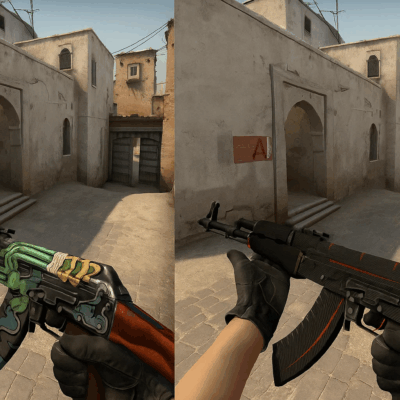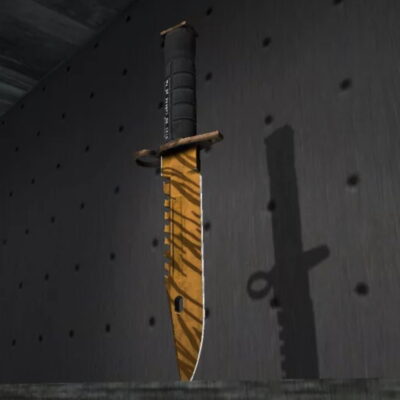The landscape of competitive Counter-Strike 2 is constantly evolving, pushing players beyond mere skill to master every advantage available. For the ambitious player, success isn’t solely defined by pinpoint aim or perfect utility usage; it also encompasses intelligent management of valuable in-game assets – your prized CS2 skins.
Gone are the days when monitoring and managing your precious inventory meant being tethered to your desktop. In our hyper-connected world, the ability to make quick, informed decisions about your digital possessions is not just a convenience, but a competitive necessity. For those committed to maximizing their potential, being able to seamlessly trade CS2 skins on the go has transformed how players interact with the market.
This seismic shift towards mobile-first solutions is reshaping the skin economy, offering unprecedented flexibility and speed. But what exactly is driving this trend, and how are Android trading apps becoming the go-to platform for serious traders and aspiring pros alike? Let’s explore why the CS2 skin market is truly going mobile-first.
The Billion-Dollar Pocket Market: CS2’s Skin Economy is Evolving
We’ve come a long way from the early days of clunky, desktop-only trading, where making a deal meant being chained to your computer, hoping you didn’t miss a golden opportunity while you were out living your life.
Let’s be clear: this isn’t some niche corner of gaming anymore. The CS2 skins market has surpassed $6 billion in value. This isn’t just about swapping a few digital items with friends; it’s a massive, living digital economy that attracts dedicated gamers, serious collectors, and shrewd investors from all over the globe. An economy of that scale simply cannot operate effectively on outdated, restrictive platforms.
You wouldn’t rely on a broker you could only call from your landline, would you? Of course not. You’d want an app that gives you real-time data and the power to act on it instantly. The same principle now applies to your virtual armory. A rare knife pattern can fluctuate in value in a matter of hours, and a new case release can send prices tumbling or soaring. The need for speed and constant access isn’t just a convenience; it’s a necessity for anyone looking to protect or grow the value of their inventory.
This is precisely why the entire ecosystem is pivoting to mobile. It’s a direct response to the market’s own explosive growth. Whether you’re a casual player who just unboxed a high-value item or a seasoned trader managing a portfolio worth thousands, being disconnected from the market means you’re already behind. The ability to monitor prices, list an item, or snap up a deal from your phone is no longer a futuristic idea—it’s the new standard for anyone who takes their assets seriously.
Why Now? The Driving Forces Behind the Mobile-First Revolution
It’s not a single spark but a perfect storm of changing player habits, maturing technology, and a market that simply outgrew its old home. The biggest driver is a generational shift. For a new wave of players who grew up with smartphones as their primary window to the world, the idea of being chained to a desk for anything—let alone managing their digital assets—feels completely alien. They expect instant, seamless access to everything, and their multi-thousand-dollar CS2 inventory is no exception.
But it’s more than just a preference for convenience. Mobile technology has finally caught up to the demands of a high-stakes economy. Early attempts at mobile trading were often clunky and, frankly, a bit scary from a security standpoint. With features like biometric logins, two-factor authentication seamlessly integrated into authenticator apps, and slick, user-friendly interfaces, trading on your phone is now as secure—if not more so—than on a desktop. This technological leap has paved the way for a more dynamic marketplace to flourish outside of the traditional Steam client.
This evolution is clear when you look at the numbers. It’s a well-known fact that third-party trading platforms now account for a staggering 60% of all CS2 skin sales. Players are actively choosing these more agile, feature-rich environments over older, more restrictive methods. When you see how platforms like Skinsmonkey have refined the process for mobile users, it’s easy to understand why the shift has been so decisive. It’s about reacting to the market in real-time, whether you’re catching a price dip on a rare knife while on your lunch break or listing a freshly unboxed glove before its value stabilizes.
Never Miss a Deal: The Power of Instant Notifications and ‘Market Sniping’
If the CS2 market is a high-speed race, then mobile apps just gave you a nitro boost. This advantage is most obvious in the high-stakes practice of ‘market sniping’—the art of scooping up a valuable skin the instant someone lists it for a fraction of its real price, often due to a simple typo. Think of a knife worth $1,500 accidentally listed for $150. These deals are gone in seconds.
So, how do you catch that lightning in a bottle? For a desktop-only user, it’s a game of pure luck and endless page refreshing. But for mobile traders, it’s a science. This is where the power of instant push notifications becomes a game-changer. Mobile trading apps give you the ability to set up targeted alerts for specific items or price points.
The moment a Dragon Lore drops below its average market price, your phone buzzes. While someone else is still logging into their computer, you’ve already seen the deal, verified it, and completed the transaction. This feature alone gives mobile users a decisive, almost unfair, advantage. It transforms trading from a passive waiting game into an active, strategic hunt where your smartphone is the ultimate weapon.
Navigating the App Store: Key Players in Android Skin Trading
Okay, so you’re sold on the idea of trading from your phone. You open up the Google Play Store and… whoa. It can feel like walking into a bazaar with a dozen vendors all shouting for your attention. How do you pick the right one? The key is understanding that it’s not about finding the single “best” app, but the one that’s best for you.
The main differences usually boil down to three things: user interface (UI), unique features, and, of course, the fees. Think of it like choosing a car. Some apps are like a slick, automatic sedan—they’re incredibly easy to use, with clean designs that guide you through a trade in a few simple taps. They’re perfect if you just want to swap a few items or cash out a new drop without getting bogged down in data. The trade-off is often slightly higher fees, but you’re paying for pure convenience.
Then you have the high-performance sports cars of the app world. These platforms are built for the serious trader. Their interfaces might look a bit more intimidating at first, packed with charts, detailed float value inspectors, and wear history. They often boast lower commission rates for high-volume users and are the tools where those instant deal alerts we talked about really shine. This is your command center for serious market-watching.
Beyond these two main types, you’ll find specialists. Some apps focus exclusively on peer-to-peer (P2P) trading, helping you connect directly with other players to bypass certain trade restrictions. Others might build a stronger social community around trading. Your choice depends on your mission. Are you a casual trader or a dedicated investor? Download a couple, explore their layouts, and see which one feels like a natural fit. The right tool is the one that makes you feel in control.
Security on the Go: Identifying a Trustworthy Trading App
When you’re dealing with an inventory that could be worth more than the phone in your hand, handing over access can feel like a leap of faith. It’s less about guesswork and more about a simple security checklist.
First and foremost, never even consider an app that doesn’t fully support two-factor authentication (2FA). Think of it as the deadbolt on your digital vault; it’s an absolute non-negotiable. Next, pay attention to how the app requests your Steam API key. A trustworthy platform will be crystal clear about the permissions it needs—it should only ask to view your inventory and facilitate trades, not for anything that could compromise your account credentials.
Finally, look for social proof. Don’t just rely on the app’s polished description; dig into real user reviews on the Play Store and forums. Is the community buzzing about fast, successful cash-outs and responsive support? To safeguard users, the most secure mobile trading apps integrate two-factor authentication (2FA), secure API key handling, transparent user reviews, and maintain a verifiable transaction history—all considered essential for trust by experienced traders.
More Than a Marketplace: The All-in-One Skin Hub in Your Hand
The best mobile trading platforms have evolved far beyond simple “buy” and “sell” buttons. Think of them less as a digital storefront and more as a complete command center for your entire CS2 inventory. The clunky days of juggling your Steam client, a third-party price-checking website, and a spreadsheet to track your assets are over. Modern apps pull all of that functionality under one roof, and they often do it better.
Ever wonder what your entire collection is worth at this exact moment? Many of these apps provide a real-time portfolio overview, calculating the total value of your skins and tracking their performance over time. They let you organize your inventory in ways Steam never could—sorting by float value, sticker application, or potential trade-up profitability. It’s the difference between having a shoebox full of collectibles and a professionally curated display case that also tells you what everything is worth.
This integration is their secret weapon. Instead of having to open a separate browser tab to check an item’s price history or inspect its exact wear pattern, these tools are built right in. You can be looking at a potential trade and, with a single tap, see its sales velocity, price charts, and 3D inspection—all without leaving the app. It’s about making smarter, faster decisions with all the necessary data right at your fingertips.
Many also lean into the social side of trading. They facilitate direct communication with other users, allowing you to negotiate deals peer-to-peer. This opens the door for more complex trades or finding that very specific item that might not be listed on a public market. The app becomes your broker, your analyst, and your communication hub, consolidating a half-dozen desktop tools into one streamlined experience in your pocket.
From Hobby to Investment: Portfolio Tracking and Market Analysis
For the casual trader, knowing the total value of their inventory is a neat feature. But for those of us treating the skin market as a serious venture, it’s the bare minimum. The best apps recognize this, transforming your phone into a financial terminal for your digital assets. This is where the line between a fun hobby and a data-driven investment truly blurs.
Forget simple value calculation. We’re talking about detailed profit/loss analysis on every single item. Top-tier apps can track an item’s value from the moment you acquire it, showing you exactly how much you’re up or down in real-time. Did that Katowice 2014 sticker you bought years ago just spike? Your app won’t just tell you its new price; it’ll show you your precise return on investment.
This level of detail extends to market-wide analysis. These aren’t just simple price charts; they are comprehensive historical sales data feeds. You can analyze an item’s performance over months or years, identify seasonal trends, and spot buy-low opportunities before the rest of the market catches on. It’s the difference between guessing what an item is worth and making an educated forecast based on hard data—all from the palm of your hand.
The Future is Now: What’s Next for Mobile Skin Trading?
If you think the current generation of mobile apps is impressive, let’s be clear: this is just the beginning. The shift to mobile wasn’t the final destination; it was the construction of a launchpad for what comes next. Having a complete command center in your pocket is the new baseline, and the future is about making that hub smarter, more social, and deeply integrated into our digital lives.
So, what’s on the horizon? The most immediate evolution is the use of artificial intelligence. We’ve moved from simple price checking to detailed portfolio analysis, but the next logical leap is AI-powered forecasting. Imagine an app that doesn’t just show you an item’s price history but analyzes market trends, player data, and even esports tournament results to suggest when a particular skin is likely to rise or fall in value. This transforms your app from a reactive tool into a proactive financial advisor for your digital assets.
We’ll also see a much deeper integration with social media. Right now, trading is a somewhat isolated activity. In the near future, you’ll be able to seamlessly share a new unboxing or a prized skin directly to your Instagram or TikTok story with a single tap. Think of built-in features that let you showcase your “Top 5 Knives” with dynamic animations, turning your inventory into shareable content and making trading a more visible, community-driven experience.
And for the truly futuristic angle, look to augmented reality (AR). Why settle for a 3D model on a screen when your phone’s camera could project that AWP | Dragon Lore onto your real-world desk? AR will allow you to inspect skins in your own environment, giving you a tangible sense of the item you’re about to spend thousands on. It’s the ultimate “try before you buy” and the next evolution of the digital display case. These innovations aren’t pipe dreams; they’re the next chapter being built on the mobile-first foundation that’s already here.
FAQ
Is it actually safe to trade valuable CS2 skins on my Android phone?
That’s the million-dollar question, isn’t it? The short answer is yes, but only if you’re smart about it. Reputable trading apps don’t ask for your Steam login and password. Instead, they use your Steam API key, which is specifically designed to let third-party services view your inventory and send trade offers without compromising your account credentials. The golden rule is to always use an app that requires Two-Factor Authentication (2FA) and has a strong, verifiable history of positive user reviews. It’s like online banking—the system is secure, but you still have to choose a trustworthy bank.
Okay, but can I really cash out and make real money from this?
Absolutely. This is the engine driving the entire third-party market. When you sell a skin on one of these platforms, the money is typically added to a wallet within your app account. From there, you can withdraw it to a real-world destination like your bank account, PayPal, or even in cryptocurrency, depending on the service. Just remember to factor in the platform’s fees for both the sale and the cash-out process when you’re calculating your profits.
Do I need a thousand-dollar inventory to benefit from these apps?
Not in the slightest. While these apps are a godsend for managing high-value collections, they’re incredibly useful for everyone. Maybe you just want to track the value of the handful of skins you’ve unboxed, find a good deal to trade up a few lower-tier items, or get alerts when a specific skin you’ve been eyeing finally drops into your price range. It’s about making asset management accessible, whether your inventory is worth $50 or $50,000.
Why can’t I just use the official Steam Mobile App for everything?
Think of it this way: the Steam Mobile App is your car keys. It’s absolutely essential for starting the engine and unlocking the doors via the Steam Guard Authenticator. But a third-party trading app is the entire dashboard, GPS, and onboard computer. It gives you the market data, portfolio analysis, and instant deal alerts you need to actually navigate the market effectively. The Steam app is for security; these other apps are for strategy.
Will I get banned by Valve for using a third-party trading app?
This is a critical concern, but you can rest easy. You will not get banned by Valve for using legitimate trading apps. These services operate by using Steam’s own API, which is a system Valve created to allow third-party applications to interact with Steam in a controlled way. The danger lies with scam sites or malicious software that ask for your direct login details. Stick to well-known, reputable apps, and you’re operating well within the established rules of the ecosystem.
What’s the single biggest advantage of mobile over desktop trading?
Immediacy. The CS2 market never sleeps, and the best deals—we’re talking items listed for a fraction of their value—are gone in seconds. A desktop trader has to be at their computer, logged in, and actively looking. A mobile trader gets an instant push notification, can verify the deal, and complete the purchase before the other person even has time to launch their browser. That speed is the ultimate, almost unfair, advantage.









